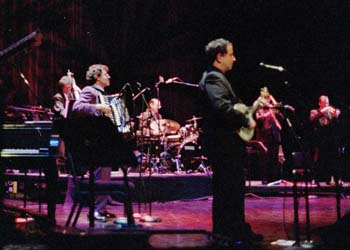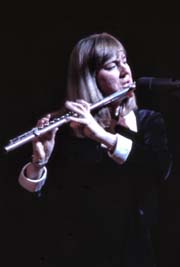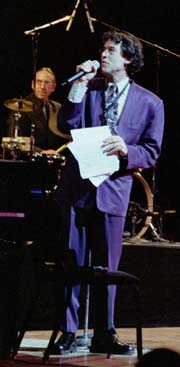
Concert Reviews
The
Klezmer Conservatory Band
Amid the religious oratorios and masses of the holiday season,
an uproarious antidote to displacement
 |
| Hankus Netsky (accordion), Jeff Warschauer (mandolin) and The Klezmer Conservatory Band. |
The Klezmer Conservatory Band
Verizon Hall, Kimmel Center for the Performing Arts, Philadelphia.
Part of
Inaugural Festival presented by Lincoln Financial Group.
Reviewed by Larry Litt Dec. 22, 2001
There's been no better way to spend the holidays than going to a concert with the whole family. Music highlights the sharing nature of the religious experience in a nonverbal, sensual way that rituals and sermons can't.
Even though I'm a long time fan of classical music, which annually includes weeks of Christmas religious oratorios and masses, I've always felt a little displaced. So this year, when the opportunity arose, I decided to go to a klezmer concert to balance out the festivities of the holiday season. It was as joyous and celebratory in its special way as any group of singers and musicians on stage or off this year.
In great part klezmer style music, whose sources are in the Eastern European Jewish music of celebrations, Yiddish theater, many songs, and movies, has been revived and promoted by the Boston-based Klezmer Conservatory Band. I caught them in Philadephia's new, architecturally breathtaking, acoustically marvelous Verizon Hall at Kimmel Center for the Performing Arts.
Indeed, what makes klezmer music so attractive to me is it's determined lack of conventional religious reverence and sanctity. Klezmer music is definitely not the ancient chants and dirges I heard in synagogue as a child. Klezmer boasts a quotidien quotient of uproarious drinking songs, wild dance numbers, wedding songs of warning and caution to both brides and grooms, and gentle lullabies that would make secure anyone's night.
 |
| Judy Bresler, vocalist of The Klezmer Conservatory Band |
Yet, to me, without authentic voices of great range and power klezmer music would be just another unique category on the music scene. It's Judy Bressler's amazing voice that sets KCB apart. She exhibits her natural, inherited gifts in songs as diverse as Mekhuteyneste Mayne (My Dear In law), Tayere Malkele (Dear Malka), Shlof In Zisn Ru (Sleep in Sweet Repose), Khaye Sho (Life's Hour), Az Der Rebbe Elimeylekh (When Rabbi Elimeykekh Gets Happy). She shows the depth of emotions that Jewish songwriters from Eastern Europe wanted to express through humanisitic, witty, and compassionate lyrics. It becomes clear that these influences made their impact on the great American songwriters of the first half of the 20th century. Yes, some of it is pure schmaltz, but what's wrong with a little bathos and pathos when you're in an auditorium full of people ecstatically sharing the feeling to the full. You must have a singer to make them laugh and cry, is a klezmer axiom.
What happens in the minutes before the intermission is the truest telling of klezmer's infectious tale. Ms. Bressler and the band offer up a wild rendition of a Bulgar dance entitled Hopkele. Its initial notes jerk seated listeners first to the left, then to the right. After the first bar the command comes from the stage, "Now is the time to dance in the aisles, even if you've never danced before. Come, make a line and wind through this beautiful new place. Do what your ancestors always did."
 |
|
The
audience rose from their seats and danced in the aisles.
|
Yes, the audience rose from their seats and danced in the aisles! And danced, and danced, for at least fifteen minutes, until they were one snaking line of people who knew each other as the ultimate object of the klezmer revival. When the music stopped there was applause not only for the Klezmer Conservatory Band but for the dancers who had fulfilled the realized promise of centuries of klezmer.
 |
| Clarinetist Ilene Stahl |
The second half of the program featured the Band's incredible musicians. Dressed in a full length sparkling red dress clarinetist Ilene Stahl opened with Sirba Miracinae, a dance tune that also featured Arthur Bailey on piano. Ms. Stahl's earlier first half solo in Kale Bazetsn (Seating the Bride) told the story of the moment in a traditional Chasidic Jewish wedding where the badkhan, or wedding jester, reads out the poems he's written to the families of both bride and groom. Often these poems contain reference to the lineage and gifts to the newly weds. By contrast the Sirba is a dance that begs you to clap along.
Among klezmer skills is the perection of a doyna, usually a wind instrument solo featuring traditional nigunim (songs) that were originally hummed or sung, as well as arranged for players. Robin Miller's Flute Doyna was a moment of contemplation of the world through the gentle tones of her flute's voice. I detected a distinctly female voice asking for love and kindness while offering compassion for all.
 |
|
Robin
Miller's Flute Doyna spoke with a female voice.
|
In a duet that was made in heaven violinist Deborah Strauss and guitar/mandolinist Jeff Warschauer recalled a moment of reality in their song about Living for Today. This advice is well taken both musically in the obviously fun loving lyrics, and socially for the times we live in.
A moment that crossed the line into another genre was Jim Guttman's double bass straight ahead jazz rendition of When the Angels Sing accompanied by Grant Smith on drums and Arthur Bailey on piano. The tune changed the mood in Kimmel Hall, bringing modernity into the nostalgia of the previous hour. But not for long.
 |
| Jim Guttman in
jazz rendition of "When the Angels Sing" |
Judy Bressler returned to sing Tif Vi Di Nacht. Her aunt sang this song in the film by the same name, and this revival is as musically engaging as its sentiment is heartfelt.
But what should come after love songs but the michigas (craziness) that Yiddish show tunes are famous for. Rumenye is the classic Yiddish comedy song. It tells the story of Romanian Jewish life in the typically sarcastic way of an oppressed people. It's also the first song I remember from my childhood. My parents had a 78 rpm recording of it by Mickey Katz and played it until the grooves were suffering as much as the Jews did in the old country. Ms. Bressler sings it in comic splendor with facial contortions and the impropriety that this song demands. Its wry and earthy, like klezmer itself. It's a release from the restraints of Jewish life of both political and religious oppression in Eastern Europe. It's the great music of a people threatened, who use humor and music to express their humanity.
 |
| Hankus Netsky has kept the Klezmer Conservatory Band alive for 20 years. |
Eternally life is with music for klezmer lovers. I'm thankful that Hankus Netsky has kept the Klezmer Conservatory Band alive for 20 years. He's an amazing teacher and enthusiast. Without his leadership the KCB might not have the traditional repertory that attracts growing followers. It's been said that klezmer's audience is growing because of identity politics. I believe klezmer is finding new audiences because of its versatility, variety, and desire to please audiences. For an encore the band played a long, sing-a-long version of Tum Balalayke, another classic that makes the heart expand almost to the verge of tears. It brings people closer, people who don't know each other personally, but share through music a cultural life. [Litt]
If you have any comments or want to notify Larry Litt about performances or shows, you can e-mail him at: humornet@aol.com.

| home |
columnists | reviews |
cue-to-cue | welcome |
| museums | recordings |
coupons | publications |
classified |